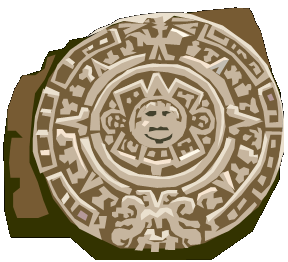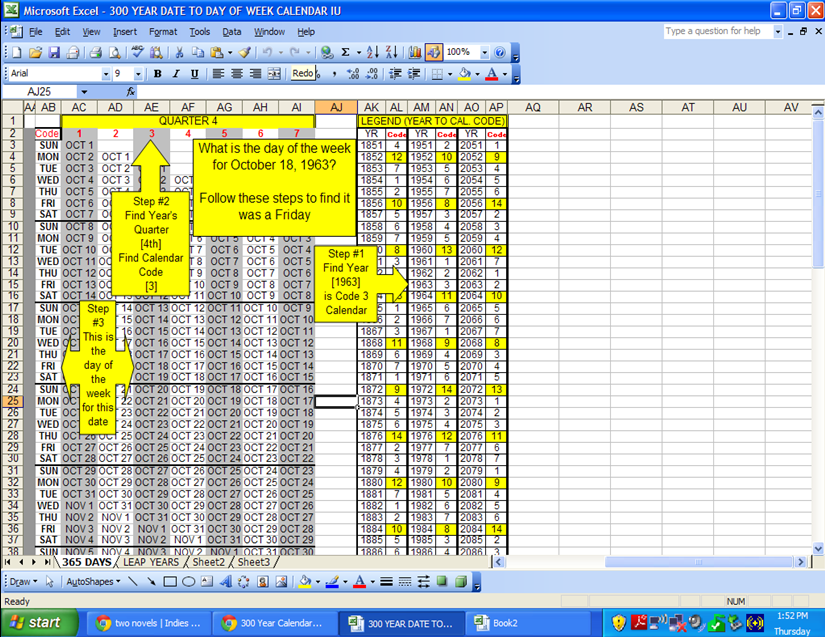 This might be of interest to those writing things that happened in the past, or even the future.
This might be of interest to those writing things that happened in the past, or even the future.
My four novels are all set in the 1960s. I felt it was important to correctly show certain days. In my first novel, the day President Kennedy was shot, my protagonist has the opportunity to console a young woman he had wanted to meet previously, but didn’t have the nerve to.
President Kennedy was shot on the 22nd of November in 1963. What day of the week was that? It was a Friday. Many of us old folk know exactly where we were standing when we heard the news he was shot in Dallas.
Sure, there are websites which will calculate the day of the week for you. Two of them I know of are:
http://www.onlineconversion.com/day_week_number.htm.
If you like doing things yourself, though, I constructed a tool using an Excel spreadsheet which you can use directly or print out. I’m glad to make this available to you for free to use as a guide when writing your novels, or just having some fun with dates. Let me know in the comments below if you’d like me to send you this matrix, and I’ll get it to you via email.
If you like detail, and want to know how to make a watch, instead of just having someone tell you what time it is, then I will explain the concept.
A year starts on one of the seven days of the week (Sunday thru Saturday). Pretty easy to depict once you know what day January 1st fell on. However, there are 365-day years, and 366-day leap years. So, instead of seven possible calendars, that means there are fourteen different possible calendars that could apply to every year including leap years.
This is a test for all those who are studying to be on “Jeopardy.” If a leap year is every year divisible by four, what year in the last 150 years was divisible by four, but not a leap year?
It was 1900.
I was surprised that a leap year is not actually every four years. The full rule for a leap year is every year divisible by four, except for years divisible by both 100 and not by 400. 1900 was not a leap year, but the year 2000 was.
Yes, it sounds complicated, but it’s not, and if you like to make your historical fiction realistic, this tool could work well for you.
What day of the week were you born on?
I hope if you get a copy of the spreadsheet you find it a useful tool. There are many other tools and good articles on the Indies Unlimited site.
Here is a sample of the spreadsheet and how to find a day of the week for October 18, 1963.


I’ve never thought about how perpetual calendars work before reading your post, Dick. Of *course* there would only be 14 possible arrangements. Thanks!
Lynne (who was born on a Saturday)
Saturday girls are fun girls…I made that up, but I’m sure you’re fun.
I dunno about that, but I do like your suggestion better than that “works hard for a living” one. 😀
I’ll buy that.
Dick, my goodness that is some project, or at least it would be for me. It is a brilliant and brings validity to the story. Thank you for an interesting post.
You’re welcome Aron. I’m a picture type person.
I’m there for you if you ever need some support.
A big thank you! I’m doing the one foot in front of the other, I trip a lot.
With every trip…you learn. Turn around and look how far behind those people are.
Or, you can just do what I do: Open Excel, enter your date into any one cell and then format that cell into “Day of the week, Month Day, Year” Format. It already has algorithms built in to calculate the day of the week.
Thanks Brian. I hope others read your reply as it is a convenient way to get the day quickly. I learned something, which I should have thought of.
You’re welcome. It’s a trick I’ve been using for a long time, actually. Excel assigns a numerical value to every date, so you can calculate lots of data with dates. Want to know what date was exactly 10,000 years ago, subtract 10,000 from todays date and format it to a date. (Just right-click the cell and select “format cells”) Subtract any two dates will give you a value that equals how many days are between them, etc.
Thanks again Brian
This looks like a big help! Would love to have a copy of the spreadsheet! Thank you! gloriareppATgmail.com
You’re welcome. I just sent the file.
This is a great post and certainly looks like a lot of work you have put into the spreadsheet. I use days and dates in my research when i’m working on my historical time travel romances to get the time frame down correctly. I’d love a copy of this spreadsheet and thank you for taking the time to put it together.
I guess that is why my daughter and nephew’s birthdays fall on Thanksgiving every 14 years? I used to think it is 11 years, do you know which is correct?
Jacqueline, I need your email. If you do not want to make it public please send me an email (dickcwaters@gmail.com).
When you get the spreadsheet you might want to answer your question using the file.
You-all could hook up using facebook, that would protect your email addresses from spammers. 🙂
You’re right Kat – unfortunate that’s the world we live in. I’ll have to see if that sign on my email fell down again…I’ll have to put it back up.
“Spammers are responsible to remove their own dead bodies.”
Hi Dick, I’ve never had a problem giving out my email address. Its been online since almost the beginning of the www. So here it is: iam14choctaw@hotmail.com.Thank you.
Wow… -eyes pop out as she stares at the spreadsheet-
When mine pop out, I put them in a bowl of warm milk. When I go to put them back I forgot where I put the bowl. Age does that. Sorry about the fine print.
The day of the week adds a touch of authenticity to historical fiction. Thanks, I hadn’t thought of that. I used a moon phase web site to make sure that, when I said in my last novel that they paddled under a full moon, there was indeed a full moon on that date.
I can barely remember when I went paddling, but I always tried to date on a new moon. Kept the laughs down if you know what I mean.
We should add your approach to how you find the moon phases to the Knowledge Base.
You can also just click on time/date on your tool bar on your Windows desktop, You can go backwards pretty quickly until you get the right month and year. That’s what I usually do.
Thanks Rich. We need to put that in the Knowledge Base.
When I buy things I always find the sale the next week.
I’ve used online conversion before, but never for that- nifty! Bookmarked!
Thanks K. There’s many ways to accomplish a task, and I’ve learned some new ones. I like a picture though.